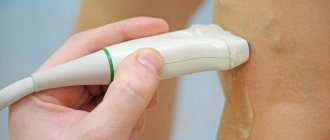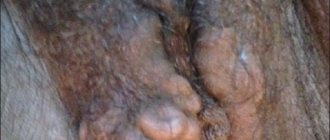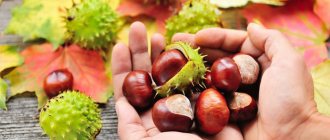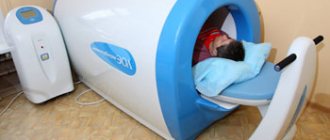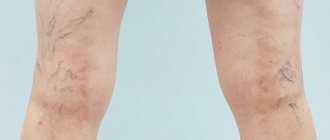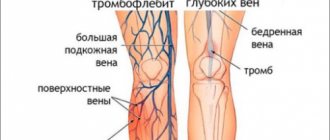Indications for use
The drug with horse chestnut extract is used for the veins of the lower extremities during postoperative complications and edema, for thromboembolism, and postpartum hemorrhoids. Internal use is indicated for rheumatic diseases, sciatica, catarrhal diseases, venous spasms, trophic skin lesions, and diseases of the gastrointestinal tract.
Tincture and decoction based on chestnut
For varicose veins, they use remedies prepared at home, as well as ready-made medications presented in the pharmacy range. The traditional medicine recipe prescribes the mechanism for preparing and using alcohol tinctures, ointments and decoctions. You can make a tincture to treat varicose veins using fruits, fresh or dried flowers, vodka or alcohol. Cooking methods:
- Chestnut flowers (50 g) pour 0.5 liters of vodka. Leave for two weeks. Then filter and take 30 drops 3 times a day before meals.
- Combine 20 g of dried chestnut flowers and 0.5 liters of 70% alcohol. The tincture is aged for about 10 days. Chestnut rub is used for varicose veins and leg cramps.
- Take 50 g of crushed fruits and leave for a week in vodka (500 ml). Strain and drink 10 drops three times a day. The course of treatment is 3 weeks, then a 7-day break.
If horse chestnut tincture with alcohol is contraindicated, then you can prepare a decoction or infusion from the bark, leaves and whole or crushed seeds. The raw materials are filled with water and simmered for 20 minutes. in a water bath. Take 30-50 milliliters 3-4 times. in a day. The finished infusion for feet is stored in a cold place for no more than 24 hours.
Cream for external use
Ointment for varicose veins with horse chestnut delivers active ingredients to the skin and promotes its trophism and regeneration, reducing swelling, and normalizing blood circulation. It is applied to the legs with light movements from bottom to top. After the manipulation, it is recommended to lie down with your legs elevated for 10-15 minutes. To prepare external medicine, use the following recipes:
- Combine fruits, flowers and base, as well as lard, vegetable or olive oil. Bring the mixture to a boil, cool and use as intended.
- Mix 5 tbsp. spoons of dried chestnut flowers, 2 parts sage, 4 chamomile and 1 tsp. starch. Keep in a water bath for 3 hours, add 200 g of pork fat.
- Take 5 pcs. chopped chestnuts and boil for 30 minutes. in 0.5 liters of oil. Apply to affected areas.
Pharmacy remedies for varicose veins based on horse chestnut
The range includes tablets, ointments, gels and tinctures that treat varicose veins and help prevent the disease. To purchase them, you do not need a prescription from a doctor, and a preliminary consultation is advisable. The most popular among them are: Escusan cream for varicose veins, 911 Gel-balm with horse chestnut, as well as Venitan ointment and Venoton solution.
"Eskuzan" and "Venitan"
The first is available in the form of gel, cream, tablets and drops, and the second is only a gel. They contain the same element - escin, obtained from horse chestnut. Pharmaceutical products have an anti-exudative, tonic and anti-inflammatory effect, prevent blood stagnation in the veins, normalize tissue trophism, relieve heaviness and discomfort in the legs, and cramps. Escusan tablets have a short-term effect, require three doses and are contraindicated in children under 12 years of age, pregnant women under 12 weeks, with renal failure and a predisposition to thrombosis. They can provoke the development of unwanted dyspeptic disorders and allergic reactions. It is recommended to apply the drugs “Eskuzan” and “Venitan” against varicose veins three times a day with light, non-massaging movements in the direction from bottom to top. It is not recommended to use them on damaged skin.
"Gel-balm 911 with horse chestnut"
It consists of an extract of chestnut fruits, red grape and hazel leaves, horsetail, ginkgo biloba, green tea, as well as cypress oil, lemon and other components. The powerful venotonic effect is due to the combination of plant components with troxerutin. Horse chestnut for varicose veins - balm “911” is recommended in complex treatment for thrombophlebitis, post-traumatic conditions, and varicose veins.
"Venoton"
Pharmacy tincture for varicose veins, which contains hazel, oats, sophora, celandine and sweet clover. It exhibits venotonic, antiexudative and capillary protective properties, and inhibits the development of inflammation. It is not recommended to combine it with antibacterial and aminoglycoside drugs. Drops are contraindicated for children, pregnant women, lactation, as well as for kidney and liver diseases, epilepsy. Take 1 tsp. tinctures, diluted in 50 ml of water and taken three times a day before meals.
Horse chestnut: application
The healing properties that horse chestnut has give it a fairly wide range of application. It is valued by the beauty industry and is used in cosmetics for the face and body, in masks and shampoos for washing hair, and also helps get rid of cellulite. In pharmacy kiosks you can find various creams, ointments and gels for feet based (with extract) of horse chestnut. A medicinal product based on horse chestnut will help in the treatment of thrombophlebitis (Thrombophlebitis), radiculitis (Radiculitis), prostatitis (Prostaritis), hemorrhoids, neuralgia (Neuralgia), leukosis (Leukosis), bronchitis (Bronchitis), radiation sickness, tuberculosis ( Tuberculosis) and many other diseases. In gynecology, products are also often used, including traditional medicine, containing horse chestnut. Horse chestnut helps stop uterine bleeding and alleviates the symptoms of menopause in women.
In general, the benefits of using horse chestnut are quite great:
- elimination of edematous syndrome and foci of inflammation;
- decreased blood viscosity;
- prevention of blood clots;
- increased venous tone;
- acceleration of blood flow in vessels;
- reducing the permeability of capillaries and the formation of stasis in them;
- lowering blood pressure;
- removal of cholesterol plaques, salt, toxins and radionuclides;
- improvement of the gastrointestinal tract (normalization of acidity, food absorption, etc.).
Horse chestnut extract
In pharmacies you can buy powder from horse chestnut seeds - a dry extract (an extract of medicinal raw materials from the plant). It has a specific smell and bitter taste. The basis of the powder is escin (Aescine) - the most valuable component of the plant, which has an anti-inflammatory and anti-edematous effect, which is especially important in the treatment of varicose veins. There is also aqueous, hydroalcoholic and glycerin extract.
Expert opinion
Although saponins are extremely beneficial for vascular health, contact with them can be hazardous to health if used incorrectly. Thus, saponins can irritate the mucous membranes of the nose, eyes, and genitals; if ingested, cause nausea and digestive disorders.
Vascular surgeon, phlebologist
Osipova Ekaterina Yakovlevna
Indications for treatment with horse chestnut in a liquid solution are varicose veins, chronic venous insufficiency and their complex therapy, fighting fungal diseases, protecting the skin from harmful ultraviolet rays, etc. The benefits of horse chestnut in the form of a liquid extract are basically the same as as from the use of other means. The choice of release form is determined by the goals; in this regard, horse chestnut fruit extract is convenient for baths. Using warm baths with the addition of liquid horse chestnut concentrate will have a beneficial effect on the entire body. Fatigue in the legs will go away, swelling will go away due to the removal of fluid from the subcutaneous tissue, microcirculation will improve, the walls of blood vessels will strengthen, and damaged areas of the skin will begin to recover.
!
The duration of such a bath is no more than 10-15 minutes.
Horse chestnut fruits: medicinal properties and use for varicose veins
Horse chestnut has a positive effect on veins and fights against the manifestations of varicose veins, this is a proven fact. Depending on the method of treatment, the fruits are used in a variety of forms - dry, fried, powdered, in infusions, etc. They stimulate the production of antithrombin, strengthen the walls of capillaries and reduce their permeability, and improve blood flow to the veins.
Horse chestnut oil: healing properties
Horse chestnut oil and its uses
This pharmacological form is made from an extract of inflorescences and fruits of the plant in combination with grape seed oil. Why and how to use horse chestnut in oil concentrate? With its help, you can get rid of rosacea, excess subcutaneous fat layer, or make a compress for swelling - to do this, you need to soak a gauze cloth or bandage folded in several rows with oil and apply it to the affected area of the body. The oil is used both in pure form and in combination with essential oils and creams. It is used for rubbing, wrapping and self-massage, promoting weight loss. Horse chestnut also promotes relaxation of tired legs and general relaxation when taking a bath; for this you need to add 30 ml of concentrate to the water.
!
In order to achieve maximum healing and cosmetic effects, it is important to carry out the procedures in courses.
Only after a certain period of constant implementation of the procedures will it be possible to note an improvement in the condition of the skin, an improvement in the outflow of lymph and, as a result, the resorption of edema and a reduction in the vascular pattern.
Horse chestnut cream for feet
Horse chestnut is very successful in showing its medicinal properties in the treatment of varicose veins. All highly effective creams contain horse chestnut. For veins, its effect is expressed in strengthening the vascular walls, improving the functioning of the valve apparatus, preventing the formation of blood clots, and even in the treatment of complications of varicose veins such as the healing of trophic ulcers. There are currently a large number of different variations of creamy venotonic preparations based on horse chestnut on the pharmacological market.
!
So there is a cream, cream-gel, cream-balm that may contain mint, shark oil, leech extract or other components, but they all certainly contain horse chestnut and are based on it.
Specialists of the pharmaceutical company VERTEX created "NORMAVEN®" foot cream, which has a unique composition of 12 active natural ingredients; one of them is horse chestnut extract. The product has been tested in clinical conditions and has all the necessary documents and quality certificates. Many women wonder about the benefits and harms of using horse chestnut cream to prevent varicose veins during pregnancy. So, clinical studies of NORMAVEN® foot cream have confirmed its effectiveness and safety of use during pregnancy. After just one month of use, there is an improvement in the condition - the pain syndrome, the feeling of fatigue and heaviness in the legs disappear. The maximum effect is achieved after 3 months of use, when applied to the skin 2 times a day with massaging movements. It should also be remembered that varicose veins and its prevention require an integrated approach. Therefore, it is important to monitor nutrition, physical activity and follow the recommendations of specialists.
Gel and ointment with horse chestnut for the treatment of varicose veins
Local remedies for the treatment of varicose veins come in various pharmacological forms and differ from each other in consistency. The gel preparation has a light consistency, while the ointment preparation is, on the contrary, dense, thick and oily. Foot ointment containing horse chestnut has both medicinal properties and contraindications. The latter include the inability to use the product for allergic reactions, etc.
!
The gel preparation is based on water, making it easier to distribute over the skin than ointment.
Therefore, massage gel-balm for feet is more convenient to use than ointment. As a rule, most products based on horse chestnut have positive reviews.
The best recipes for the treatment of varicose veins
Tablets for varicose veins: a list of the best remedies for varicose veins on the legs, prices
Traditional medicine offers a huge selection of remedies for strengthening the blood vessels of the body. But when we talk about varicose veins of the legs, the effective drug will be the one made from horse chestnut.
Let's look at the most popular of them.
Decoctions
The recipes involve using the kernels (nuts) of the plant and its leaves. You will need:
- chopped nuts - 1 tsp;
- water - 200 ml.
How to prepare and take:
- Combine the ingredients and simmer over low heat for about 10 minutes.
- Take the remedy for varicose veins on an empty stomach, 1-2 tablespoons three times a day.
In the recipe for a healing decoction, you can use chestnut peel in the same proportions.
Remember the cumulative effect of the medication, which is taken for 2-3 months to achieve a positive result.
Ointment
To make a healing ointment with horse chestnut, you will need a fatty base, such as Vaseline. Prepare:
- crushed kernels and inflorescences of the plant;
- Vaseline or pork fat.
How to prepare and use:
- Mix the ingredients in a 1:1 ratio and simmer over low heat for about 1.5 hours.
- After this, strain the mixture.
- Apply the cooled balm for varicose veins externally.
It is important not only to prepare the product correctly, but also to use it. For example, a light foot massage should be carried out with chestnut cream strictly in an upward direction in the morning and evening.
Tinctures
A simple and very effective herbal medicine is horse chestnut tincture. Both kernels and flowers can be used in the recipe. However, it is worth taking into account the alcohol component when choosing an anti-varicose vein therapy.
To prepare the elixir from the nut core you will need:
- kernels - 6 pieces;
- medical alcohol - 500 ml.
How to cook:
- Mix the ingredients in a glass container and wrap it in a thick dark cloth.
- Set the dishes aside in a dark place for 2 weeks. Shake the jar periodically.
- After time, strain the solution and put it in the refrigerator.
Take this remedy for varicose veins in courses of 3 weeks. The daily dose is 30 drops twice a day. Then you can take a 10-day break.
The flowers of the plant are also used in alcoholic tinctures made from chestnut. Take:
- inflorescences - 30 g;
- alcohol - 200 ml.
How to prepare and take:
- Mix the ingredients and wrap the jar with a thick cloth as in the previous recipe.
- Infuse the solution for about 2 weeks in a dark place, then strain and take 50 drops 2 times a day.
The mixture is stored only in the refrigerator!
Alcohol infusion of chestnut can have a negative effect on the body if you are intolerant to alcohol. In these cases, it is recommended to drink water extracts.
Horse chestnut baths
A convenient and effective method of combating the manifestations of varicose veins of the lower extremities is the use of baths with the green part of the plant. To do this you will need:
- fresh or dry leaves - 500 g;
- water - 3 l.
Scheme of preparation and use:
- Mix the ingredients and simmer in a water bath for a quarter of an hour.
- Then leave the mixture for some time.
- Soak for 15 minutes in a comfortable container that covers your shins, such as a bucket, once a day.
The deciduous part can just as easily be replaced with tree bark, chopped for convenience. The proportions and step-by-step preparation are the same.
Compresses
In mixtures for the treatment of inflamed veins, fresh chestnut flowers are used, which are crushed to a paste and applied to the affected area of the leg, wrapped overnight in medical wax paper for compresses.
You cannot use cellophane for wrapping, as you may get diaper rash.
Rubbing
It is recommended to use chestnut tinctures for varicose veins externally in the form of rubs. To do this, a small amount of the medicine must be rubbed in the morning and evening with light massage movements into the areas of inflammation.
The course lasts about 2 months.
Such vascular therapy is carried out several times a year.
Kvass according to Bolotov's recipe
A tasty and healthy drink is prepared from the nuts of the medicinal plant, fermented with fermented milk starter. The following ingredients will be required:
- chestnuts - 30 pcs.;
- sugar - 1 tbsp;
- whey - 0.5 tbsp.
How to prepare and eat:
- Weight the nuts in a fabric bag and place them at the bottom of a 3-liter bottle.
- Fill with water, adding sugar and fermented milk drink.
- Leave the solution for the fermentation process for 2 weeks in a dark place.
- Take kvass half an hour before meals for a month.
Instead of the first 1-2 glasses poured from the container, add new water and a spoonful of sugar to the drink. Thus, the kvass will be renewed within 2-3 months. However, do not forget to add fresh nuts.
Is it possible to make your own ointment with horse chestnut for varicose veins?
Yes, there is nothing complicated about preparing ointment at home. To do this, you will need tree fruits and animal fat. You need to take 50 grams of fruit and grind it to flour. Then place the chestnut in a non-stick bowl and mix with animal fat (badger fat will do).
Place on the fire and simmer until low heat for about 40 minutes. After this, remove the ointment from the heat and let it cool. Transfer the resulting product to a convenient, clean container.
This method of preparing the product is very convenient and does not require much effort. At the same time, the resulting ointment can be used for prophylactic purposes and as a component of complex therapy for varicose veins. An ointment with this composition improves blood circulation in the legs, has a venoprotective effect and reduces feelings of fatigue.
Pharmaceutical medicines based on horse chestnut
Plant-based drug Angionorm for the treatment of varicose veins
Pharmacological preparations, which include chestnut (usually the fruit), make up the lion's share of pharmacy shelves, where they are crowded. These are drops, gels, ointments, tablets, capsules, extracts. Each product is accompanied by an annotation that describes the rules of use, indications, restrictions and contraindications.
In the production of pharmaceutical products, maximum extraction of substances acting on the veins occurs, which is impossible to achieve at home. It is obvious that pharmacy products are more effective than home remedies.
The most popular and effective:
- Aescusan drops;
- Balm Varicobooster;
- Aescin Gel;
- Cream and gel Venitan.
You can always ask the pharmacist about the assortment and ask about the effectiveness of the chosen drug.
Manufacturers of dietary supplements are keeping up with the pharmaceutical industry. These do not skimp on generous promises and present their pills as a panacea.
For example, Naturonic Chestnut capsules for varicose veins and hemorrhoidal pathologies promise to radically eliminate vascular problems.
Contraindications for use
Pharmaceutical drugs also have their contraindications for use. These include: bleeding tendency, hemophilia, first trimester of pregnancy, lactation, allergies, exacerbation of duodenal ulcers, diabetes, low blood pressure and acute renal failure.
However, it should be emphasized that pharmaceutical preparations have a higher concentration of the active substance and have a high degree of purification, which is simply impossible to achieve at home. Of course, finished industrial products are always better than domestic ones in terms of efficiency and effectiveness.
Ointments for varicose veins on the legs
The most effective medications for varicose veins - list of tablets, creams and ointments
If treatment is impossible at the third stage of varicose veins, then at its early appearance you can still save yourself. And don't put it off. Drug treatment includes the active use of drugs that help narrow the veins. In this article we will look at what is the best cream for varicose veins on the legs.
Tasks:
- Relieving symptoms and minimizing them.
- Elimination of possible complications (consequences).
- Preventing inflammation.
- Treatment of the venous network and normalization of its work.
ointments are divided into three types:
- Phlebotonics.
- Blood thinners.
- Anti-inflammatory.
Phlebotonics
Medicines that improve the structure of blood vessel walls, as well as increase blood flow.
Known ointments for varicose veins of the lower extremities:
- Troxevasin (ointment, gel, capsules). Ideal help in the fight against varicose veins. Prevents the formation of blood clots, has an antioxidant, tonic and anti-inflammatory effect. Average price - 160 rubles.
- Venoruton. Cream for varicose veins, strengthens the walls of blood vessels, penetrates deep into the skin. Cost - 300 rub.
- Angistax. Increases the tone of venous vessels, relieves pain, increases the elasticity of blood vessels. Average price - 500 rub.
- Reparil-gel. Protects blood vessels, reduces pain and swelling. Average price - 200 rub.
- Troxerutin. Reduces the fragility of capillaries, strengthens the walls of blood vessels, and has a wide range of benefits against varicose veins. Average price - 160 rubles.
Horse chestnut ointments:
- Venitan. Reduces capillary fragility, reduces inflammatory processes. The average price is 250 rubles.
- Girudoven. Antiseptic effect, relieves pain with menthol, strengthens the walls of blood vessels. Average price - 110 rubles.
Blood thinners
Medicines to prevent blood clots. Almost all of them are heparin-based.
- Lyoton 1000. Eliminates the formation of blood clots, reduces the risk of thrombosis. A good, inexpensive and effective ointment. Relieves fatigue. The average price is 250 rubles.
- Venolife. Prevents the formation of blood clots. The average price is 250 rubles.
- Gepatrombin-G. Heals damaged tissue, prevents the formation of blood clots, and helps in the prevention of existing blood clots. Average price - 160 rubles.
- Trombless. Slows down the inflammatory process, blood clotting, and also reduces swelling and relieves pain. The average price is 300 rubles.
Anti-inflammatory drugs
- Diclofenac. Analgesic, antipyretic, anti-inflammatory effect. The average price is 50 rubles.
- Indomethacin. Analgesic, anti-inflammatory drug. The average price is 50 rubles.
Is it possible to refuse surgical treatment in favor of ointment with horse chestnut for varicose veins?
No, you can't do this. If a phlebologist, after an examination, recommends surgical treatment of varicose veins, this means that the dilation of the veins has reached pronounced values. No creams or medications can return blood vessels to their previous state. In such situations, the only correct solution is to remove varicose veins.
Fortunately, today's technologies make it possible to do this without harm to health, without pain and without complications. The main methods that are now actively used are Laser surgery and Radiofrequency Ablation. These procedures have virtually nothing in common with standard surgical treatment.
They are based on access to the vein through a minimal incision (a few mm) and the avoidance of general anesthesia. And vascular sclerosis refers to non-operative treatment methods, during which a specialized drug is injected into the lumen of the vein. Sclerotherapy is especially effective in the initial stages of the disease.
Creams and ointments for varicose veins can speed up recovery in the postoperative period. In this regard, they are often prescribed by phlebologists.
Chestnut-based recipes
Medicines can be prepared from horse chestnut, which differ radically in the method of application.
Taking into account the possibility of using different types of raw materials, we will consider the best recipes against varicose veins from this plant
Decoctions
If we talk about decoctions, there are 2 effective and proven recipes:
- To prepare, you will need to chop 5 grams of horse chestnut leaves and fruits. Next, fill the raw material with 200 milliliters of water and simmer in a water bath for 30 minutes after the water becomes hot. Then the resulting broth is filtered, the cake is thrown away and boiled water is added to the liquid so that the volume becomes the same. For the first 2-3 days, take 1 tablespoon three times a day; if there is no negative reaction from the body, the frequency of doses is tripled;
- Another recipe is based on the use of still green chestnut peels, so it can be prepared mainly in early spring. Chop the peel with a knife, take 2 tablespoons and add a liter of water. Cook the raw materials over low heat for 10 minutes, then cover with a lid and let stand for at least 7 hours. Then the broth is filtered and taken for a month before bedtime, a teaspoon.
Ointments
Before describing recipes for preparing ointments, it is worth noting that they are prepared on the basis of butter or cocoa butter, as well as Vaseline. Now let's look at several effective cooking methods:
- Take 5 tablespoons of inflorescences and 5 peeled fruits, grind them in a blender or using a mortar. Next, thoroughly mix the resulting slurry with 500 grams of one of the mentioned types of base. The resulting mass is placed in a water bath and heated for 2 hours. After the mixture has cooled, it must be strained, packaged in a glass container and stored in the refrigerator. Using the ointment, make compresses or rub it into problem areas up to 2 times a day;
- The second method is somewhat simpler; you need to mix Vaseline (or another base) only with the inflorescences in a 1 to 1 ratio; after thoroughly mixing, the mass is allowed to sit for about 5-6 hours. This is followed by a heat treatment process, during which the mass is evaporated in a water bath for one and a half hours, after which it is also cooled and filtered. You can use this ointment in the same way; you can also make wraps with both recipes.
Chestnut tincture
Tinctures
Tinctures are one of the main types of combating varicose veins; there are several variations of their recipes:
- The fruits along with the peel are cut into small pieces and 50 grams of crushed raw materials are poured with 2500 milliliters of medical alcohol in a glass container (vodka can be used). The container is tightly sealed and placed in a dark place at room temperature for 14 days; the container must be shaken every 2-3 days. After the specified period, the resulting tincture is filtered through cheesecloth and stored in the refrigerator. For treatment, you need to drink 15 drops of the medicine three times a day, the course of treatment does not exceed 21 days. A repeat course is carried out no earlier than a week later, the dosage is reduced to 10 drops at a time.
- Pour 3 tablespoons of dried horse chestnut inflorescences with 500 milliliters of medical alcohol and leave in a dark place for 30 days. The finished tincture is filtered and taken half a teaspoon three times a day.
- Do not rush to throw away the chestnut peel when harvesting the fruit; you can also make a healing tincture from it. To do this, take about 50 grams of peel, pour 500 milliliters of vodka in a glass container and leave for 2 weeks in a dark place, stirring occasionally. However, this tincture is not drunk; it is customary to rub problem areas with it.
Other recipes
In early spring, during the flowering period of the chestnut tree, a seasonal medicine can be prepared from its freshly picked inflorescences. To do this, collect the flowers, clearing them of leaves and sticks, then using a mortar, crush until the juice appears, strain, separating the juice from the debris. The resulting juice can be taken orally, approximately 2-3 milliliters per day, or rubbed several times a day into the areas where varicose veins appear.
How to collect and prepare
Pharmacy chains offer us a large selection of dry horse chestnut preparations. However, if the plant grows in your area, it is quite possible to prepare it for future use yourself and use it in the treatment of varicose veins. Different parts of the plant can be used, the harvesting methods are slightly different.
- The collection of leaves and inflorescences begins in May, at the time when the tree or shrub begins to bloom profusely. The raw materials are washed under running water. Dry on paper or dry cloth, laying them out in a ventilated room, hiding from direct sunlight. Such drying can take a long time, so the raw materials need to be stirred daily to prevent them from becoming moldy.
- Horse chestnut kernels are harvested in the fall, just before the fruits become round and begin to ripen. Ripe kernels do not have a high content of medicinal components, so the kernels are collected in an unripe form. If you need to clear the kernels from the green peel, then remove it with a knife.
- The fruits of the plant are often used for treatment. They are selected in an already mature state. If necessary, grind it using a meat grinder or use it whole.
- The tree bark is removed at any time and crushed before drying.
Dry the kernels, bark and fruits in the same way as the leaves - in a dark place where it is warm and has good air circulation.
Important! If drying horse chestnut is done incorrectly, the plant will be useless during treatment - it will lose the main part of its medicinal components.
Collection of preparations for tinctures
- Chestnut fruits or seeds are freed from the pericarp, dried on racks, spread out in an even layer. Drying takes a long time, about 3-4 weeks. Can be dried in a dryer at a temperature of 40 - 60 degrees for 2 - 3 days. If the fruits are dried correctly, they have a rich brown color, a shiny surface, a dense outer capsule with a gray spot at the very base of the fruit, and taste astringent. Shelf life – 12 months.
- The bark is collected in the spring from branches that are 3-5 years old. Dry in the attic or any room with good ventilation. Shelf life – 12 months.
- The leaves are collected from May to September, while they are still green and do not fall off. It is better to collect from young trees up to 3 meters high. Dry under a canopy, in a well-ventilated room or in a dryer, spread out in an even layer. When drying under natural conditions, the raw materials are periodically turned over. The finished raw material remains green; the petioles should break when bent. Shelf life – 24 months.
- The inflorescences are collected before dry flowers appear, dried naturally, spread out in a thin layer. Shelf life – 12 months.
Before preparing chestnut tincture for joints, it is important to properly collect all its components. Only high-quality ingredients are suitable for use in tinctures, collected at the appropriate time and in an environmentally friendly place (preferably in a forest), away from roads and other objects that pollute the air (for example, industrial buildings)
Chestnut blossoms begin in late spring; at this time you can begin to collect its flowers and leaves. The buds are collected in early spring (late March), and the fruits (circular shell with spikes) closer to mid-autumn (early October). One fruit contains 2-3 seeds of bright brown color and flattened shape.
Why do phlebologists prescribe venotonic ointments and gels?
Why do many phlebologists at European-level urban phlebological centers continue to prescribe various ointments for varicose veins? In the complex treatment of venous pathology, good local remedies play a positive role, the condition of the surface layers of the skin improves, and there are certain effects on the smallest vessels (arterioles, venules, capillaries).
The use of ointments in the context of modern treatment is a good practice, but you should not expect miracles and replace the main component of the treatment of varicose veins, the removal of these same veins, with an ointment or gel.
Diagnosis of varicose veins. What to do? Personal experience and description of how the cream works.
The diagnosis of varicose veins, namely varicose veins, was inherited from my father’s side. In addition, I am overweight, which also affects the condition of my veins.
️ What help do I expect from the cream? ️
I need the cream to relieve me of such symptoms of varicose veins as:
- Fatigue in the calves;
- Heaviness in the calves;
- Swelling of the legs below the knee.
️ How to live with varicose veins? ️
The first and most important rule to remember: Varicose veins love walking. Walk more, take walks. In the gym, I always walk on a treadmill, at fast speed, but I walk, not run.
It is necessary to improve blood flow, so physical. Loads will be of great help to you with this disease.
With a long absence of movement: a sedentary lifestyle, sedentary or standing work, all the delights of varicose veins will certainly make themselves felt. Then they come to the rescue: cream, compression stockings, therapeutic exercises.
Try to sleep with your legs not bent so as not to squeeze the veins.
Of course, it is necessary to do an ultrasound scan of the veins of the lower extremities to fully understand the state of health.
️ Why is it normal? ️
At the pharmacy I was looking for a foot cream with horse chestnut, because once upon a time a cream with this particular component helped me a lot. The pharmacist recommended Normaven, and that’s how my love for this product began.
The cost of the cream is about 300₽ in Moscow pharmacies. Tube volume 150ml. Consumption is economical. I only bought two tubes in a year.
The ingredients of natural origin are very effective. Let's look at the quote.
Chestnut extract
Refers to strong antioxidants; is a source of esculin, escin, flavonoids, which stimulate tissue metabolism processes, eliminate the feeling of heaviness and fatigue in the legs.
Green tea extract
It is the strongest natural antioxidant, stimulates hydrocarbon and lipid metabolism, reduces swelling.
Ginkgo biloba extract
It has a venotonic, antihypoxic effect, normalizes metabolism in cells and improves skin microcirculation.
Lingonberry extract
It has good general strengthening and tonic properties due to the content of useful organic acids, pectin and vitamins.
Arnica extract
Stimulates microcirculation, accelerates the process of resorption of bruises and helps reduce the severity of spider veins.
Panthenol
Accelerates regeneration processes, moisturizes, nourishes and protects the skin.
Lemon oil
Maintains skin firmness and elasticity, improves its tone.
Wormwood extract
It is a natural antiseptic and has healing properties.
Menthol
It has a local irritant effect, soothes skin receptors, alleviating the condition and reducing discomfort in the legs.
️ How I use the cream ️
The cream is very thick, so even a small drop will fall in a thick layer on the surface of the legs and will not be absorbed immediately.
To avoid staining my clothes, I use the cream in the morning after a shower, half an hour before getting dressed. So, I give a great boost of energy to already tired legs in the morning!
I apply the cream only to the calves using upward movements, while doing a 5-minute leg massage for varicose veins.
I use the cream when I start to feel heaviness in my legs. Once a day in the morning I smear my feet for 10-15 days. It turns out to be a mini course, the effects of which last for a long time, but here everything is individual and largely depends on lifestyle.
️ Effect of the cream ️
Instantly a tingling cooling sensation is felt on the legs. This effect really helps with the feeling of fatigue in the calves. After about 30 minutes, the cooling will begin to subside and by the middle of the day the feeling of heaviness and fatigue will begin to return. Therefore, it is advisable to use the cream as a course in combination with therapeutic exercises. So, you will definitely revive tired legs!
️After using the cream, be sure to wash your hands thoroughly! Otherwise, it will be very unpleasant if the cream gets on your face or, especially, in your eye. A burning sensation in this case is inevitable.
From time to time I get bruises on my calves. Using Normaven prevents them from appearing.
️The manufacturer notes that the cream can be used by pregnant women. He also recommends a 3-month course.
Varicose veins are a chronic disease and it is no longer possible to get rid of it. However, Normaven will help you relieve your symptoms. The cream fully met my expectations!
Thank you for reading my review!
You might be interested:
Liquid soap of a well-known brand with a poor composition.
The healing properties of horse chestnut for varicose veins
It is the medicinal properties of horse chestnut that even doctors immediately remember when it comes to the occurrence of varicose veins. The benefits of this plant for varicose veins have long been proven; treatment is considered fast and effective.
Externally, horse chestnut is a small shrub no more than 1.5 meters high or a huge tree up to 25 m in height. In the treatment of this disease, inflorescences are mainly used - white and pink candles, which have the greatest medicinal properties:
- the degree of swelling decreases;
- swelling subsides;
- the heaviness of the legs weakens, weakness and fatigue are felt less;
- the skin stops itching;
- the size and volume of the veins returns to normal, the veins themselves become elastic and dense;
- the general condition of the patient improves.
The medicinal properties of horse chestnut treatment are due to the fact that the plant is enriched with a large amount of vitamins, minerals, and tanning components. Particularly important substances are escin and esculin. Thanks to them, blood circulation improves and the formation of blood clots is prevented. Blood viscosity is normalized, and muscles become toned.

